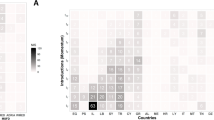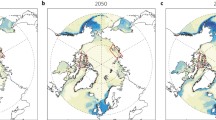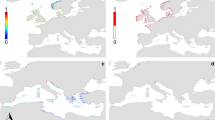Abstract
Species movements in relation with global warming may increase the spatial overlap between exotic and endemic species, which is a critical issue for the conservation of biodiversity. The Mediterranean Sea, which is a receptacle for exotic species while being a hotspot for endemism, provides exceptional material for a case study. The aim of our study was to quantify (i) the increasing invasion from southern fish exotic species (Red Sea and Atlantic Ocean) that the Mediterranean biota is experiencing and (ii) the spatial overlap between exotic and endemic Mediterranean fish fauna following the northward movement of exotic species within the Mediterranean Sea in the context of global warming. The historical invasion dynamic of exotic fish species and the sea surface temperature series were reconstructed from 1810 to 2006 in order to estimate the correlation between invasion rate and climate. The geographical distributions of exotic and endemic fish richness before and after the period of global warming were used to assess the dynamic of spatial congruence. The results revealed (i) an acceleration of successful introductions from the Red Sea and (ii) the introduction of Atlantic species from lower latitudes in correlation with the increasing temperature of the Mediterranean Sea. We also showed an increasing overlap between the spatial distributions of endemic and exotic species richness. Taken together, our results suggest that endemic fish species are facing a growing number of exotic species because the Mediterranean Sea is acting as a catchment basin for southern species.




Similar content being viewed by others
References
Akyol O, Unal V, Ceyhan T, Bilecenoglu M (2005) First confirmed record of Lagocephalus sceleratus (Gmelin, 1789) in the Mediterranean Sea. J Fish Biol 66:1183–1186
Azzurro E, Andaloro F (2004) A new settled population of the lessepsian migrant Siganus luridus (Pisces: Siganidae) in Linosa Island—Sicily Strait. J Mar Biol Assoc UK 4:819–821. doi:10.1017/S0025315404009993h
Azzurro E, Pizzicori P, Andaloro F (2004) First record of Fistularia commersonii (Fistularidae) from the central Mediterranean. Cybium 1:72–74
Ben Souissi J, Zaouali J, Bradai MN, Quignard JP (2004) Lessepsian migrant fishes off the coast of Tunisia. First record of Fistularia commersonii (Osteichthyes, Fistularidae) and Parexocoetus mento (Osteichthyes, Exocoetidae). Vie Milieu Life Environ 4:247–248
Ben Souissi J, Golani D, Mejri H, Capape C (2005) On the occurrence of Cheilopogon furcatus in the Mediterranean Sea. J Fish Biol 4:1144–1149. doi:10.1111/j.0022-1112.2005.00790.x
Ben Tuvia A (1953) Mediterranean fishes of Israel. Bull Sea Fish Res Stn Isr 8:1–40
Bethoux JP, Gentili B, Raunet J, Tailliez D (1990) Warming trend in the western Mediterranean deep-water. Nature 6294:660–662. doi:10.1038/347660a0
Blackburn TM, Duncan RP (2001) Establishment patterns of exotic birds are constrained by non-random patterns in introduction. J Biogeogr 28:927–939. doi:10.1046/j.1365-2699.2001.00597.x
Briggs JC (2007) Marine biogeography and ecology: invasions and introductions. J Biogeogr 34:193–198. doi:10.1111/j.1365-2699.2006.01632.x
Castriota L, Andaloro F (2004) First record of the lessepsian fish Siganus luridus (Osteichthyes: Siganidae) in the Tyrrhenian Sea. JMBA2-Biodiversity records. http://www.mba.ac.uk/jmba/pdf/5122.pdf
Castriota L, Greco S, Marino G, Andaloro F (2002) First record of Seriola rivoliana Cuvier, 1833 in the Mediterranean. J Fish Biol 2:486–488
Catalano E, Zava B (1993) Sulla presenza di Stephanolepis diaspros fr. Brunn. Nelle acque italiane (Osteichthyes, Monacanthidae). Supp Ric Biolo Selvaggina 21:379–382
Chakroun F (1966) Captures d’animaux rares en Tunisie. Bull Inst Nat Sci Tech Oceanogr Pech Salammbo 2:75–79
Corsini M, Margies P, Kondilatos G, Economidis PS (2005) Lessepsian migration of fishes to the Aegean Sea: first record of Tylerius spinosissimus (Tetraodontidae) from the Mediterranean, and six more fish records from Rhodes. Cybium 4:347–354
Davis MA (2003) Biotic globalization: does competition from introduced species threaten biodiversity? Bioscience 53:481–489. doi:10.1641/0006-3568(2003) 053[0481:BGDCFI]2.0.CO;2
Diaz Almela E, Marba N, Duarte C (2007) Consequences of Mediterranean warming events in seagrass (Posidonia oceanica) flowering records. Glob Change Biol 13:224–235. doi:10.1111/j.1365-2486.2006.01260.x
Dulçic J, Pallaoro A (2004) First record of the marbled spinefoot Siganus rivulatus (Pisces: Siganidae) in the Adriatic Sea. J Mar Biol Assoc UK 5:1087–1088
Dulçic J, Pallaoro A (2006) First record of the oceanic puffer (Lagocephalus lagocephalus lagocephalus Linnaeus, 1758), for the Adriatic Sea. J Appl Ecol 1:94–95
Duncan RP, Blackburn TM, Daniel S (2003) The ecology of bird introduction. Annu Rev Ecol Evol Syst 34:71–98
Faouzi H (1951) Le Canal de Suez, voie d’échanges biologiques entre la Méditerranée et la Mer Rouge. Annu Centre Univ Medit Nice 5:23–30
Filiz H, Er M (2004) Akdeniz’in Yeni Misafiri (New guests in the Mediterranean). Deniz Magazin (Istanbul) 52–54
Galil BS (2007) Loss or gain? Invasive aliens and biodiversity in the Mediterranean Sea. Mar Pollut Bull 55:314–322. doi:10.1016/j.marpolbul.2006.11.008
Gökoglu M, Bodur T, Kaya Y (2003) First record of the Red Sea bannerfish (Heniochus intermedius Steindachner, 1893) from the Mediterranean Sea. Isr J Zool 49:324–325
Golani D (2000) First record of the bluespotted cornetfish from the Mediterranean Sea. J Fish Biol 6:1545–1547. doi:10.1111/j.1095-8649.2000.tb02163.x
Golani D (2002) The Indo-Pacific striped eel catfish, Plotosus lineatus (Thunberg, 1787), (Osteichtyes: Siluriformes) a new record from the Mediterranean. Sci Mar 3:321–323
Golani D (2004) First record of the muzzled blenny (Ostelchthyes: Blenniidae: Omobranchus punctatus) from the Mediterranean, with remarks on ship-mediated fish introduction. J Mar Biol Assoc UK 4:851–852. doi:10.1017/S0025315404010057h
Golani D, Fine M (2002) On the occurrence of Hippocampus fuscus in the eastern Mediterranean. J Fish Biol 3:764–766. doi:10.1111/j.1095-8649.2002.tb01700.x
Golani D, Sonin O (2006) The Japanese threadfin bream Nemipterus japonicus, a new Indo-Pacific fish in the Mediterranean Sea. J Fish Biol 3:940–943. doi:10.1111/j.0022-1112.2006.00961.x
Golani D, Orsi Relini L, Massuti E, Quignard JP (eds) (2002) The CIESM atlas of exotic species in the Mediterranean, vol 1. Briand Edition, Monaco
Goren M, Aronov A (2002) First record of the Indo-Pacific parrot fish Scarus ghobban in the eastern Mediterranean. Cybium 3:239–240
Goren M, Galil BS (2005) A review of changes in the fish assemblages of Levantine inland and marine ecosystems following the introduction of non-native fishes. J Appl Ecol 4:364–370
Gorgy S (1966) Les pêcheries et le milieu marin dans le secteur Méditerranéen de la République Arabe Unie. Rev Trav Inst Pech Marit 30:25–92
Hickling R, Roy DB, Hill JK, Thomas CD (2005) A northward shift of range margins in British Odonata. Glob Change Biol 11:502–506. doi:10.1111/j.1365-2486.2005.00904.x
Huntley B (1991) How plants respond to climate change: migration rates, individualism and the consequences for the plant communities. J Bot 67:15–22
Ktari F, Ktari MH (1974) Présence dans le Golfe de Gabès de Siganus luridus (Rüppell, 1829) et de Siganus rivulatus (Forsskal, 1775) (Poissons, Siganidae) parasités par Pseudohaliotrematodides polymorphus. Bull Inst Nat Sci Tech Oceanogr Pech Salammbo 1–4:95–98
Ktari Chakroun F, Boualal M (1971) Capture de Siganus luridus (Rüppell) dans le Golfe de Tunis. Bull Inst Nat Sci Tech Oceanogr Pech Salammbo 1:49–52
Lande R (1993) Risks of population extinction from demographic and environmental stochasticity and random catastrophes. Am Nat 142:911–927. doi:10.1086/285580
Mac Kinney ML, Lockwood JL (1999) Biotic homogenization: a few winners replacing many losers in the next mass extinction. Trends Ecol Evol 4:450–453
Menendez R, Gonzalez Megias A, Hill JK, Braschler B, Willis SG, Collingham Y, Fox R, Roy DB, Thomas CD (2006) Species richness changes lag behind climate change. Proc R Soc Lond B 273:1465–1470
Mills MD, Rader RB, Belk MC (2004) Complex interactions between native and invasive fish: the simultaneous effects of multiple negative interactions. Oecologia 141:713–721. doi:10.1007/s00442-004-1695-z
Mouneimne N (1979) Poissons nouveaux pour les côtes Libanaises. Cybium 6:105–110
Olden JD, Poff NL, Bestgen KRL (2006) Life-history strategies predict fish invasions and extirpations in the Colorado River basin. Ecol Monogr 76:25–40. doi:10.1890/05-0330
Orsi Relini L (2002) Occurrence of the South American fish Pinguipes brasilianus in the Mediterranean. Cybium 26:147–149
Orsi Relini L, Costa MR (1986) Cattura di un Marlin a Camogli: segnalazione di Makaira indica (Civier, 1832) (Osteichthyes, Istiophoridae) nel Mediterraneo. Doriana 6:1–4
Orsi Relini L, Palandri G, Garibaldi F, Gavagnin PF (1995) First record of Beryx splendens (Osteichthyes, Berycidae) in the Mediterranean. Cybium 19:317–319
Parenti P, Bressi N (2001) First record of the orange-spotted grouper, Epinephelus coioides (Perciformes: Serranidae) in the northern Adriatic Sea. Cybium 3:281–284
Parmesan C, Ryrholm N, Stefanescu C, Hillk JK, Thomas CD, Descimon H et al (1999) Poleward shifts in geographical ranges of butterfly species associated with regional warming. Nature 399:579–583. doi:10.1038/21181
Perlmutter A (1956) Sea fisheries. Report to the government of Israel, Technical Assistance Program USOM Agricultural Report: 58
Perry AL, Low PJ, Ellis JR, Reynolds JD (2005) Climate change and distribution shifts in marine fishes. Science 308:1912–1915. doi:10.1126/science.1111322
Pizzicori P, Castriota L, Marino G, Andaloro F (2000) Seriola carpenteri: a new immigrant in the Mediterranean from the Atlantic Ocean. J Fish Biol 5:1335–1338. doi:10.1111/j.1095-8649.2000.tb00491.x
Quignard JP, Tomasini JA (2000) Mediterranean fish biodiversity. Biol Mar Medit 3:1–66
Ragonese S, Giusto GB (1997) Chaunax pictus Lowe 1846—first record of the family Chaunacidae in the Mediterranean Sea. J Fish Biol 5:1063–1065
Reina Hervas JA, Raso JEG, Manjon-Cabeza ME (2004) First record of Sphoeroides spengleri (Osteichthyes: Tetraodontidae) in the Mediterranean Sea. J Mar Biol Assoc UK 5:1089–1090. doi:10.1017/S0025315404010495h
Reynolds RW, Rayner NA, Smith TM, Stokes DC, Wang W (2002) An improved in situ and satellite SST analysis for climate. J Clim 15:1609–1625. doi:10.1175/1520-0442(2002) 015<1609:AIISAS>2.0.CO;2
Risso A (ed) (1810) Ichthyologie de Nice ou histoire naturelle des poissons du département des Alpes-Maritimes. Schoell, Paris
Roemer GW, Donlan CJ, Courchamp F (2002) Golden eagles, feral pigs, and insular carnivores: how exotic species turn native predators into prey. Proc Natl Acad Sci USA 99:791–796. doi:10.1073/pnas.012422499
Smith MD, Knapp AK (2001) Size of the local species pool determines invisibility of a C-4 dominated grassland. OIKOS 92:55–61. doi:10.1034/j.1600-0706.2001.920107.x
Somot S, Sevault F, Deque M (2006) Transient climate change scenario simulation of the Mediterranean Sea of the twenty-first century using a high resolution ocean circulation model. Clim Dyn 27:851–879. doi:10.1007/s00382-006-0167-z
Streftaris N, Zenetos A, Papathanassiou E (2005) Globalisation in marine ecosystems: the story of non-indigenous marine species across European seas. Oceanogr Mar Biol-an Annual Review 43:419–453
Thomas CD, Lennon JJ (1999) Birds extend their ranges northwards. Nature 399:213. doi:10.1038/20335
Tillier JE (1902) Le Canal de Suez et sa faune ichthylogique. Mem Soc Zool Fr 15:279–318
Vacchi M, Chiantore MC (2000) Abudefduf vaigiensis (Quoy & Gaimard, 1825): a tropical damselfish in Mediterranean Sea. Biol Mar Medit 7:841–843
Vitousek PM, Mooney HA, Lubchenco J, Melillo JM (1997) Human domination of Earth’s ecosystems. Science 277:494–499. doi:10.1126/science.277.5325.494
Walther GR, Post E, Convey P, Menzel A, Parmesan C, Beebee TJC et al (2002) Ecological responses to recent climate change. Nature 416:389–395. doi:10.1038/416389a
Whitehead PJP, Bauchot L, Hureau JC, Nielsen J, Tortonese E (eds) (1986) Fishes ofthe north-eastern Atlantic and the Mediterranean. UNESCO, Paris
Wilson RJ, Thomas CD, Fox R, Roy DB, Kunin WE (2004) Spatial patterns in species distributions reveal biodiversity change. Nature 432:393–396. doi:10.1038/nature03031
Zibrowius H (2002) Assessing scale and impact of ship-transported alien fauna in the Mediterranean? In CIESM (2002) Alien marine organisms introduced by ships in the Mediterranean and Black seas. CIESM Workshop, Monographs 63–68
Acknowledgments
The authors wish to express their gratitude to the Cooperation and Cultural Action Services of the French Embassy in Tunisia, which funded this research by a PhD grant. This project was also supported by the Total Foundation.
Author information
Authors and Affiliations
Corresponding author
Appendix
Appendix
Rights and permissions
About this article
Cite this article
Ben Rais Lasram, F., Mouillot, D. Increasing southern invasion enhances congruence between endemic and exotic Mediterranean fish fauna. Biol Invasions 11, 697–711 (2009). https://doi.org/10.1007/s10530-008-9284-4
Received:
Accepted:
Published:
Issue Date:
DOI: https://doi.org/10.1007/s10530-008-9284-4




